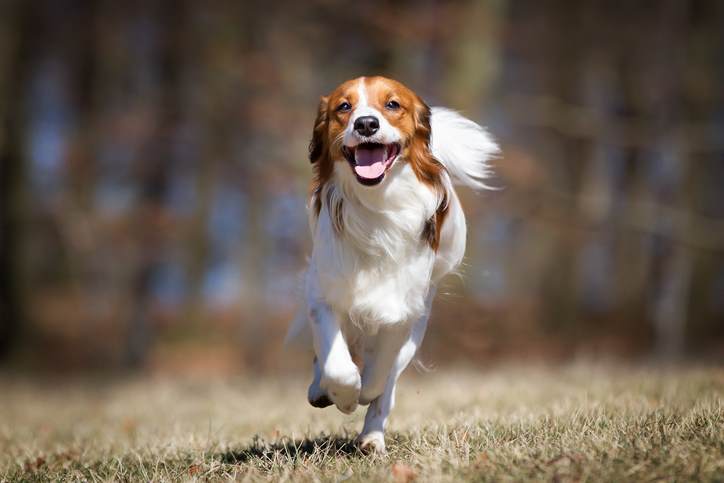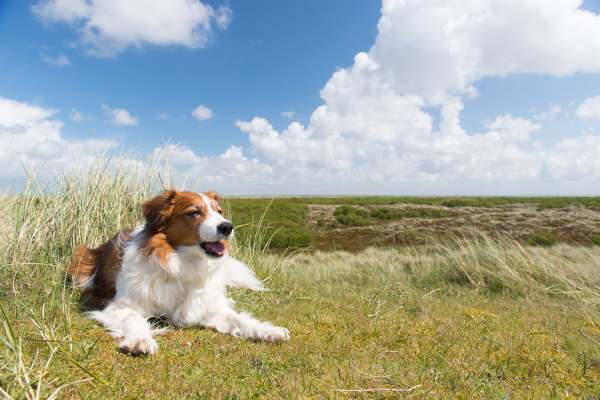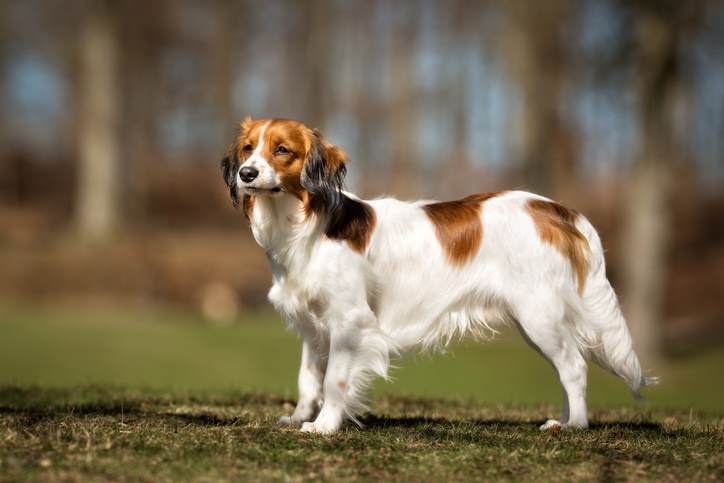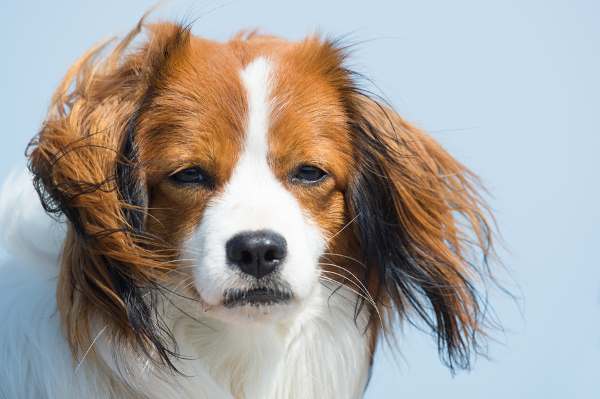Kooikerhondje, A Happy Breed, Rare Outside of Europe
by Janice |Updated 11-26-2023
The Nederlandse Kooikerhondje (pronounced Koi-ker-hond-yuh) is a happy, intelligent and adaptable breed that was originally developed as a working dog to help duck hunters. Even early in the breed’s history, people realized how suitable these dogs were for family life and they developed the reputation as also serving as a beloved family pet.
These dogs are always white and orange with a full thick tail and an expression that makes the dog look like they are smiling. Their tails are feathered with a thick white plumb.
They are playful and full of life yet always watchful and somewhat reserved with strangers. Their sensitive nature makes it difficult for them to make friends with people, children or dogs immediately.
Once he has accepted someone, though, he is loyal for life. They tend to be a one-person dog, but if socialized from early on to enjoy the company of a family with children, Kooikers can make excellent playmates for children.
They are self-confident, good-natured and always alert. Though sensitive to loud noises and sudden movements, they are not aggressive and are not considered to be a noisy breed.
Their sensitive nature may make them more vulnerable to a harsh correction. They respond best to positive methods and praise. They have a strong prey drive which also means they enjoy retrieving games and they also love swimming.
They are an active breed and need enough stimulation, both physical and mental to keep them happy. Daily exercise is necessary as well as plenty of human interaction. They are highly intelligent, eager to please, and easily trained, yet prolonged repetitive methods will not work with these dogs.
They do well in dog sports such as Obedience, Flyball, Agility, even Dock Diving.
Quick Facts
Other Names Used: Dutch Decoy Dog, Kooikers, “little white and orange dog with a big heart” literal English translation is “little cager dog”
Affiliation: AKC Sporting FSS, KC Utility, FCI Flushing Dog
Size
Height: 38-40 cm (15 to 16 inches) (females are slightly smaller)
Weight: 9-13 kg. (20-28 lbs.)
Coat Type: Silky with seasonal shedding; Thick, medium length, naturally waterproof
Colors: White with orange-red markings, black tipped ears
Country of Origin: The Netherlands
Activity Level: Somewhat Active
Life Expectancy: 12-14 years
Good with Children: Yes, if raised and socialized properly
Good with other dogs: Yes, if raised and socialized properly, Not good with small pocket size pets such as gerbils and hamsters.
History
The Kooikerhondje has a long history dating back to the 1500 and 1600s when Dutch hunters used them to lure ducks into traps, a method of hunting called tolling.
Their name comes from the type of work they did. The duck hunters were called Kooiker and hondjes’ means dog. So, the name, Kooiker’s hondjes literally refers to Kooiker’s dogs. It was later shortened to Kooikerhondje.
During the “off” season, they would search out and destroy vermin such as rats, mice and moles. When not working, they were considered a much-loved pet.
The Dutch nobility also loved this breed and you can find these dogs included in paintings by Dutch masters.
During the 1920s, Dutch hunters were beginning to use guns rather than the decoys, so fewer dogs were needed. Therefore, fewer dogs were being bred.
However, the reemergence of the breed can be attributed to Baroness Van Hardenbroek Ammerstol. She searched the countryside for these spaniel type dogs and when one was found and mated with one of her own dogs. Tommie, the founding bitch was mated with Bobbie and they produced a litter.
She began this breeding program during 1942 and 1943, a period when Nazi Germany occupied the Netherlands.
Breeding Dutch dog breeds became a sign of a silent resistance during World War Two.
Eventually others became interested in the breed and continued breeding over the years. On December 20, 1971, the breed received recognition by the Dutch Kennel Club and the stud books were closed. By then, there was enough gene pool to sustain the breed.
Today, they are still very rare but are now beginning to gain recognition throughout North America. Though not recognized in Canada yet, they have been part of the American Kennel Club, FSS program in 2004.
| Traits | Rating |
|---|---|
| Playfulness | |
| Affection Level | |
| Friendliness Towards Strangers | |
| Good with Children | |
| Good with Other Dogs | |
| Good for First Time Owners | |
| Exercise Needed | |
| Ease of Training | |
| Watch Dog Ability | |
| Grooming Requirements | |
| Shedding | |
| Cold Tolerant | |
| Heat Tolerant |
Dog Breed Ratings Got You a Little Confused?
Here's a little help in understanding them
- Playfulness: Most Playful = 5 Least Playful = 1
- Affection: Most Affectionate = 5 Least Affectionate = 1
- Friendliness Towards Strangers: Most Friendly = 5 Least = 1
- Good With Children: Great= 5 Not Good with Children = 1
- Good With Dogs: Great = 5 Not Good Around Dogs = 1
- Good With First Time Owners: Fine=5 Not Appropriate = 1
- Exercise Required: Extensive Daily Exercise = 1 Minimal = 1
- Ease of Training: Very Easy = 5 Difficult = 1
- Watch Dog: Excellent Watch Dog = 5 Minimal = 1
- Grooming: Time Consuming = 5 Minimal = 1
- Shedding: Heavy Shedder = 5 Minimal = 1
- Cold Tolerance: Well Tolerated = 5 Poor Tolerance = 1
- Heat Tolerance: Well Tolerated = 5 Poor Tolerance = 1
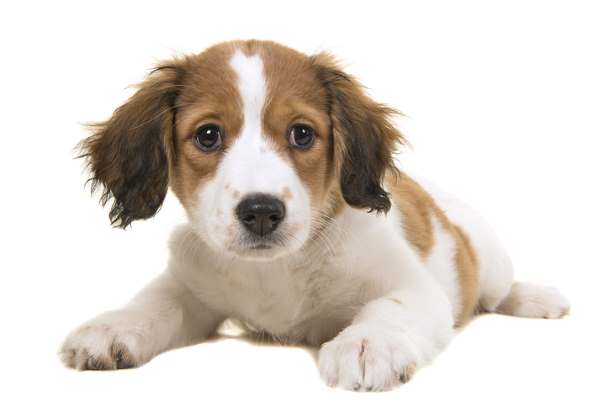 Kooikerhondje Puppy
Kooikerhondje PuppyPersonality
The Kooikerhondje is a friendly, even-tempered dog who is eager to please. They are self-confident, and alert making them a good watchdog. Originally bred to lure ducks into enclosures and kill vermin they have a strong prey drive which might make them unsuitable for owners who also have small pocket pets.
They are active, enjoy playing, retrieving and even swimming, but are equally happy to lie on a comfortable couch near their owners. Puppies and young adults will need more opportunities for physical exercise and mental activities to keep them happy. Without adequate socialization, training, and exercise, a Kooiker may find other ways to pass the time, most of which are not those desired by their owners.
They are adaptable and will fit in with many different lifestyles. They want to be part of the action and won’t do well if left alone for long periods of time.
If they have plenty of opportunities to exercise, they do very well in apartments. The breed does tend to do best when they don’t have to share their home with other dogs, though most will accept the presence of other canines if socialized with them.
If socialized from puppyhood, they can make great companions for respectful children. Since they don’t tolerate loud noises or sudden movements, children should be taught how to interact appropriately with these dogs.
Some Kooikers are cautious and reserved around strangers, but never mean. Early and ongoing socialization is needed if you want your Kooiker to not only accept but enthusiastically welcome all of your visitors.
Grooming the Kooikerhondje
These dogs are easy to groom by brushing about once per week. Bathing is recommended when dirty or smelly. Frequent bathing is not recommended as it robs the coat of the natural waterproof properties.
Ears should be checked and cleaned as needed. Other than clipping the nails when long and brushing the teeth, grooming these dogs is very easy.
Health Concerns
This breed is relatively healthy and national breed clubs have been very diligent to encourage breeders to do genetic testing and health screens prior to using a dog for breeding. All dogs, however are prone to some disorders, many of which cannot be eliminated. Here is a list of issues that have been identified in the breed.
VON WILLEBRAND’S DISEASE (vWD)
VWD is a hereditary clotting disorder caused by a deficiency of a blood clotting protein, called von Willebrand Factor, that is required for platelet formation. This problem causes abnormal and excessive bleeding which can be a major problem during surgeries or accidents.
PATELLAR LUXATION
In patellar luxation, the kneecap pops out of place causing lameness. It is a hereditary defect but can also be caused by over-exercise or malnutrition. It is relatively common in small breed dogs.
HIP DYSPLASIA
This condition occurs when the bones of the hip joint are not formed properly. The joint does not rotate properly causing pain and lameness from mild to crippling. Although it is an inherited defect, environmental facts such as obesity, over-exertion, or an improper diet play a part.
Other diseases that have been identified include Epilepsy, Kidney Disease, Polymyositis and eye problems.
Pros
- Intelligent, alert, easy to train
- Minimal grooming
- Relatively healthy
- Active but quiet indoors
- Adapts to Apartment Living if given enough exercise opportunities
- Good Watchdogs
Cons
- Relatively rare outside of Europe
- Rare normally means expensive and difficult to find
- Not a good choice for families with loud boisterous children
- Not suitable for individuals who don’t have the time to develop to training and socialization
About Janice (author and voice behind this site)
Janice Jones has lived with dogs and cats for most of her life and worked as a veterinary technician for over a decade. She has also been a small-breed dog breeder and rescue advocate and holds academic training in psychology, biology, nursing, and mental health counseling. Her work focuses on helping dog owners make informed, responsible decisions rooted in experience, education, and compassion.
When not writing, reading, or researching dog-related topics, she likes to spend time with her six Shih Tzu dogs, her husband, and her family, as well as knitting and crocheting. She is also the voice behind Miracle Shih Tzu and Smart-Knit-Crocheting
Does This Article Deserve Your Thumbs Up?
We always appreciate your support and encouragement. Your thumbs up means so much to us. Please like this article.
If you find this page or any page on Small Dog Place Helpful, or useful in anyway, I'd love it if you would click the small heart found on the bottom right of each page.
You can also share or bookmark this page -- just click on the:

Free Monthly Newsletter
Sign Up for Our Free Newsletter and get our Free Gift to You.
my E-book, The Top 10 Mistakes People Make When Choosing a Dog (and how to avoid them)
